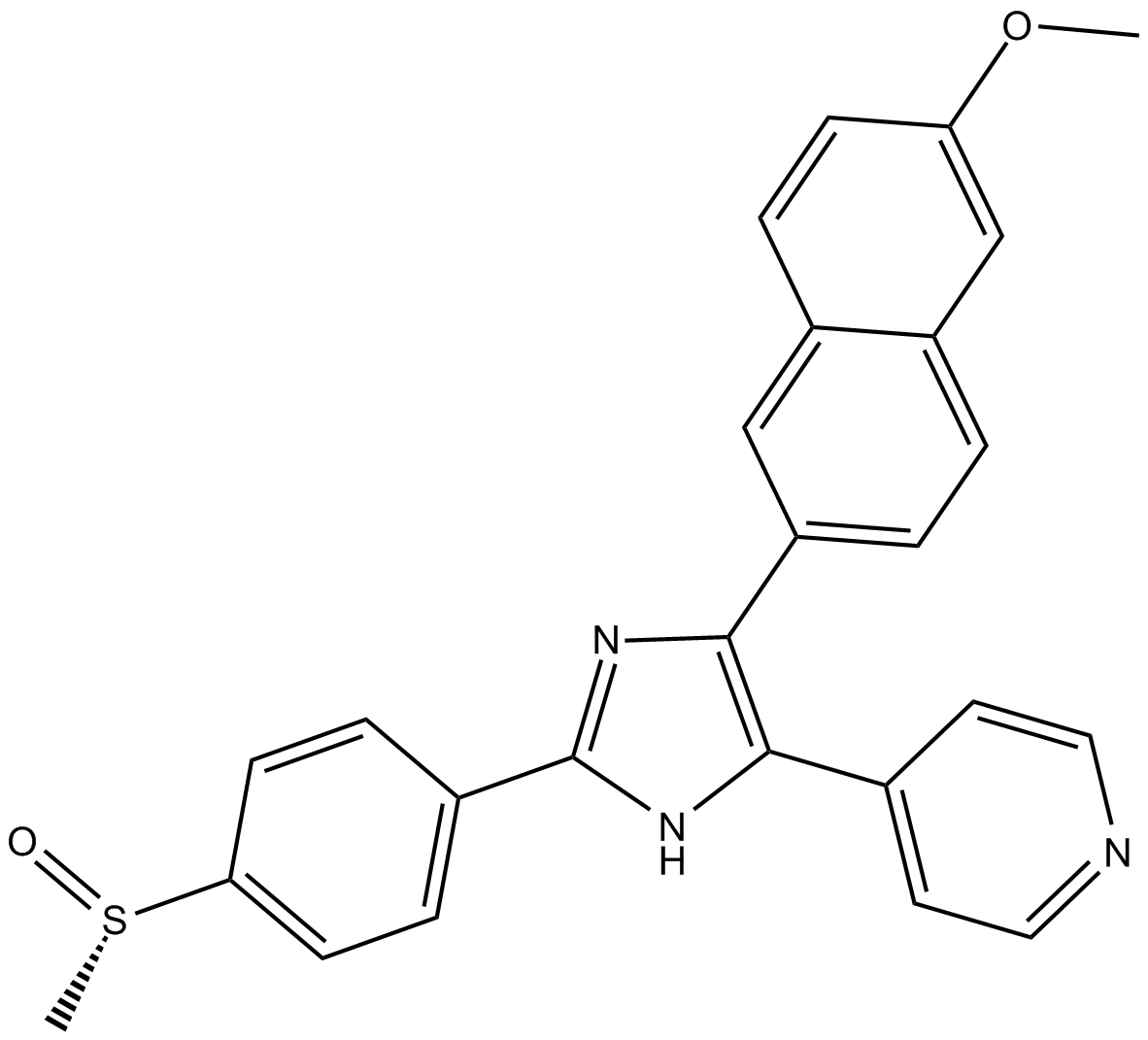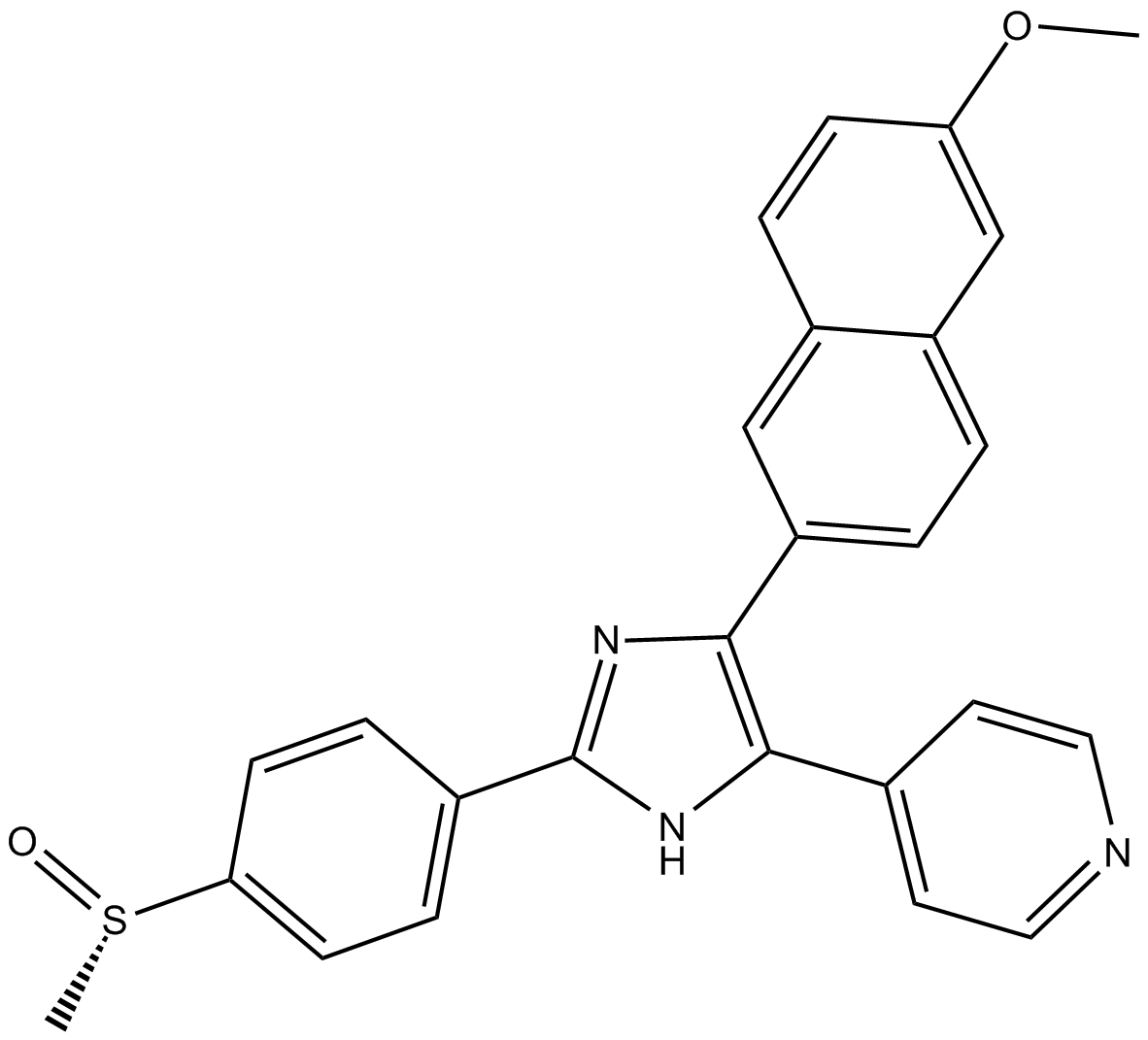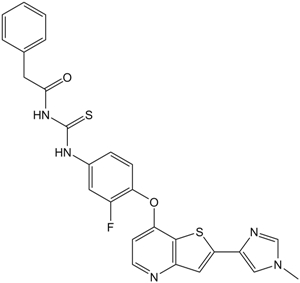Tie2 kinase inhibitor
IC50: A reversible and selective inhibitor of Tie2 with IC50 of 0.25 M, whose selectivity is 200-fold higher than that of p38.
Genetic studies have identified the crucial roles of Tie receptors (Tie1 & Tie2) in the development and function of endothelial tissues, including promoting the survival, maturation and functional integrity of the vasculature. Tie2 kinase inhibitor is suggested to block vascular construction via suppressing Tie2, and in this way it is expected to disrupt tumor growth and angiogenesis. [1]
In vitro: Tie2 kinase inhibitor exhibited significant inhibitory effect on Tie2 auto-phosphorylation and disrupted its downstream signal transduction in a dose dependent manner in human aortic endothelial cells. In addition, Tie2 kinase inhibitor exhibits moderately suppressed the activity of Tie2 tyrosine kinase in HEL cells with IC50 of 232 nM. [2, 3]
In vivo: Matrigel mouse model of angiogenesis was adopted for in vivo study. Tie2 kinase inhibitor at doses of 25 and 50 mg/kg (i.p., b.i.d) reduced 41% and 70% of angiogenesis, respectively. In a MOPC-315 plasmacytoma xenograft model, Tie2 kinase inhibitor modestly suppressed tumor growth in nude mice in a dose-dependent manner. [4]
Clinical trial: A phase I study was conducted in patients with low or intermediate-1 International Prognostic Scoring System risk MDS to evaluate safety, pharmacokinetics (PK), pharmacodynamics (PD), and preliminary responses of Tie2 kinase inhibitor. It was noticed that this kind of compounds could be well tolerated and has sufficient activity. 1,200 mg once daily was a recommended dose for further study. [5]
References:
[1] LaGreca S, Arcari J, Baker D, Borzillo G, Chen J, Clark T, Cohen B, Hungerford W, Kakar S, Kanter A, Knauth K, Lu Y, Martinez-Alsina L, Marx M, Patel N, Soderstrom C, Tkalcevic G, Thompson C, Troutman M, Vincent P, Wessel M. Identification of selective, orally active Tie2 kinase inhibitors and discovery of CE-245,677 and PF-371,989. Cancer Res. 2007 May; 67: 3259.
[2] Liu L , Lina T, Coleb A, Wenc R, Zhao L, Bresciab MR, Jacoba B, Hussainb Z, Appella K, Hendersonb I, Webba M. dentification and characterization of small-molecule inhibitors of Tie2 kinase. FEBS Lett. 2008 Mar; 582(5): 785-91.
[3] Semones M, Feng Y, Johnson N, Adams JL, Winkler J, Hansbury M. Pyridinylimidazole inhibitors of Tie2 kinase. Bioorg Med Chem Lett. 2007 Sep; 17(17): 4756-60.
[4]Hasenstein JR, Kasmerchak K, Buehler D, Hafez GR, Claery K, Moody JS, Kozak KR. Efficacy of Tie2 receptor antagonism in angiosarcoma. Neoplasia 2012 Feb;14(2):131-40.
[5] Garcia-Manero G, Khoury HJ, Jabbour E, Lancet J, Winski SL, Cable L, Rush S, Maloney L, Hogeland G, Ptaszynski M, Calvo MC, Bohannan Z, Kantarjian H, Komrokji R. A phase I study of oral ARRY-614, a p38 MAPK/Tie2 dual inhibitor, in patients with low or intermediate-1 risk myelodysplastic syndromes. Clin Cancer Res. 2015 Mar 1;21(5):985-94.
| Storage | Store at -20°C |
| M.Wt | 439.53 |
| Cas No. | 948557-43-5 |
| Formula | C26H21N3O2S |
| Solubility | ≥22 mg/mL in DMSO; insoluble in H2O; insoluble in EtOH |
| Chemical Name | (S)-4-(4-(6-methoxynaphthalen-2-yl)-2-(4-(methylsulfinyl)phenyl)-1H-imidazol-5-yl)pyridine |
| SDF | Download SDF |
| Canonical SMILES | COc(cc1)cc(cc2)c1cc2-c1c(-c2ccncc2)[nH]c(-c(cc2)ccc2[S@](C)=O)n1 |
| Shipping Condition | Small Molecules with Blue Ice, Modified Nucleotides with Dry Ice. |
| General tips | We do not recommend long-term storage for the solution, please use it up soon. |
| Kinase experiment [1]: | |
|
Tie2 kinase activity assay |
Turned on an incubator shaker and adjusted temperature to 30 °C. Added 20 μL of 3× kinase buffer (final 20 mM Tris-HCl, pH 7, 100 mM NaCl, 12 mM MgCl2, 1 mM DTT) per well to the Flashplate. Added 20 μL of protein per well except for background. Added Tie2 Kinase Inhibitor, typically 1 ~ 2 μL in DMSO stocks. Added 20 μL of a mixture of gamma 33p-ATP and cold ATP (1:1 v/v) per well. Covered with transparent polyester film. Incubated at 30 °C for 2 hrs in shaker, washed five times. Read plate on TopCount or other counting instrument, and results were calculated as IC50 values using normal methods. |
| Cell experiment [1]: | |
|
Cell lines |
HEL cells |
|
Preparation method |
The solubility of this compound in DMSO is >10 mM. General tips for obtaining a higher concentration: Please warm the tube at 37℃ for 10 minutes and/or shake it in the ultrasonic bath for a while. Stock solution can be stored below -20℃ for several months. |
|
Reaction Conditions |
232 nM |
|
Applications |
In HEL cells, Tie2 Kinase Inhibitor moderately suppressed the activity of Tie2 tyrosine kinase, with an IC50 value of 232 nM. |
| Animal experiment [1]: | |
|
Animal models |
Mouse model of angiogenesis |
|
Dosage form |
25 or 50 mg/kg; i.p.; b.i.d. |
|
Applications |
In a mouse model of angiogenesis, Tie2 Kinase Inhibitor, at doses of 25 or 50 mg/kg (i.p., b.i.d.), reduced 41% and 70% of angiogenesis, respectively. |
|
Other notes |
Please test the solubility of all compounds indoor, and the actual solubility may slightly differ with the theoretical value. This is caused by an experimental system error and it is normal. |
|
References: [1]. Semones M, Feng Y, Johnson N, Adams JL, Winkler J, Hansbury M. Pyridinylimidazole inhibitors of Tie2 kinase. Bioorg Med Chem Lett. 2007 Sep; 17(17): 4756-60. |
|
Quality Control & MSDS
- View current batch:
Chemical structure










